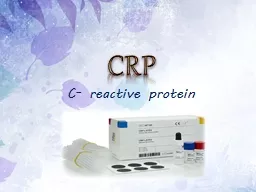

Creactive protein was originally discovered as a substance in the serum of patients with acute inflammation that react with the C polysaccharide of pneumococcus this protein which cause the reaction is called CRP ID: 908129
Download Presentation The PPT/PDF document "CRP C- reactive protein C- reactive prot..." is the property of its rightful owner. Permission is granted to download and print the materials on this web site for personal, non-commercial use only, and to display it on your personal computer provided you do not modify the materials and that you retain all copyright notices contained in the materials. By downloading content from our website, you accept the terms of this agreement.
Slide1
CRP
C- reactive protein
Slide2C- reactive protein (CRP)C-reactive protein was originally discovered as a substance in the serum of patients with acute inflammation that react with the C polysaccharide of pneumococcus, this protein which cause the reaction is called CRP.It is an acute phase protein which act as a non specific inflammatory indicator.
Slide3Characteristics of CRPCRP is alpha-globulin produced in liver.CRP is acute phase protein that appears in sera of individuals in response to inflammatory conditions (e.g. rheumatoid arthritis and lupus …,etc.) and some forms of cancer.Increase within 4-6 hours following infection, surgery or trauma.CRP also elevated due to inflammation in the arteries of the heart and is a marker for coronary artery disease called high sensitive CRP(
hs- CRP).
Slide4CRP is not specific. A high result serves as a general indication of acute inflammation but can’t show where the inflammation is located or what is causing it so, Other tests are needed to find the cause and location of the inflammation.It is thermolabile destroyed by heating at 70◦ C for 30 min.Don’t cross human placenta.Act as opsonin to help in complement activation and has a receptor on
phagocytic cells.
Slide5CRP pathophysiology
Slide6CRP and coronary heart diseaseHs CRP appears within one to two days of acute myocardial infarction, peaks at 3 days and becomes negative after seven days Failure of CRP to return to normal signifies tissue damage in the cardiac or other tissues. Hs CRP correlates with peak CKMB following acute myocardial infarction.
CRP may remain high for at least three months following acute myocardial infarction.
Slide7When it is ordered?Suspected inflammatory state (vasculitis, autoimmune disorders, SLE, infection)May sometimes be ordered along with erythrocyte sedimentation rate (ESR)hs-CRP can be ordered for patients with some established risk factors of coronary heart disease to determine strategy for prevention of cardiovascular events and for follow-up of patients with acute coronary syndromes.
Slide8When it is ordered?CRP may be ordered, for example, when a newborn shows signs of infection or when an individual has symptoms of sepsis, such as fever, chills, and rapid breathing and heart rate.CRP may also be ordered to monitor conditions such as rheumatoid arthritis and lupus and is often repeated at intervals to determine effectiveness of treatment.
Slide9When it is ordered?Check for infection after surgery. CRP level normally rise within 4-6 hr of surgery and then go down by the third day after surgery. If CRP level stay elevated after 3 days of surgery, an infection may be present.
Check to see how well treatment is working, such as treatment for cancer or an infection. CRP
level rise rapidly with infection but quickly become normal if you are responding to treatment
.
Slide10CRP vs ESRBoth are indicators for non specific inflammation, but CRP is a more sensitive and accurate reflection of the acute phase response than the ESR, since ESR may be normal while CRP is elevated
But.. CRP appears and disappears more quickly than changes in ESR. Therefore, your CRP level may drop to normal following successful treatment, whereas ESR remain elevated for a longer period.
Days post stimulation
Slide11Conditions in which CRP is normal whereas ESR is increased:Pregnancy due to increase in fibrinogen.Nephrosis in which hypoalbuminemia present but fibrinogen and globulins increased.Anemia.
Drugs (steroids).
Slide12Normal value: 0.02-1.32 mgldlCRP Test :-1 drop of reagent is mixed with 50ul of sample.
If positive: serial dilution is done to detect the titer. If negative: serial dilution is done to exclude probability of very high concentration of CRP “prozone
effect”
Titer is detected by multiplying dilution factor by 0.6 mg/dl or 6 mg/L.
Slide1350ul50ul50ul
sample
50ul
50ul
50ul
1:2
1:4
1:8
+
+
+
-
-
-
12
24
48
6
Titer (mg/L) =
NS
NS
NS
Add
1
3
2
Total
Dilution
agglutination
And so on;
Slide14